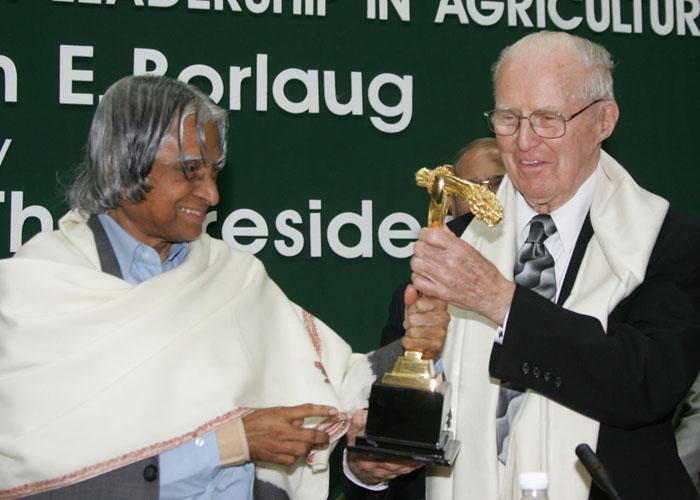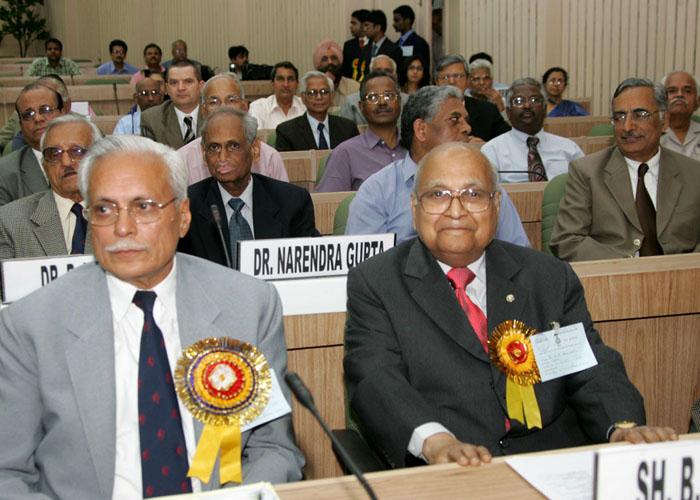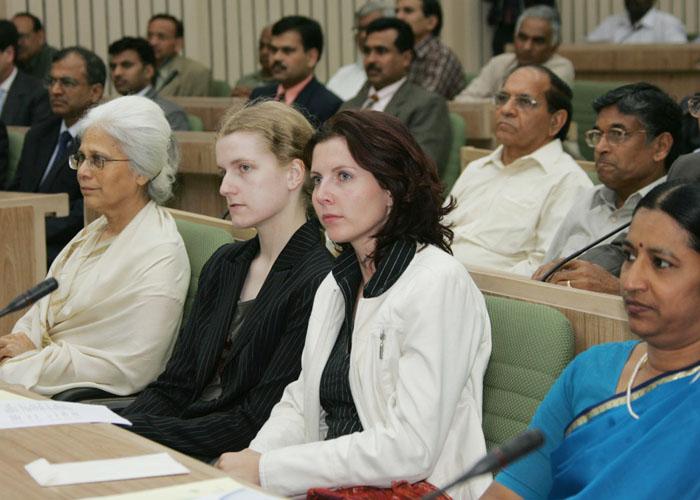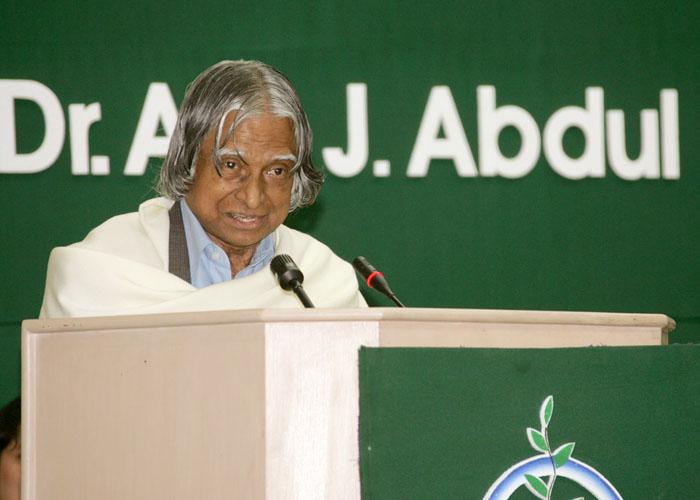Address at the Presentation of the First Dr. M.s. Swaminathan Award
New Delhi : 15-03-2005
Dr.Norman Ernest Borlaug and the mission
I am indeed delighted to participate in the presentation of the ?Ist Dr. M.S. Swaminathan Award for Food? to Nobel laureate Dr. Norman Borlaug, organized by the Trust for Advancement of Agricultural Sciences (TAAS). I greet the agricultural scientists, technologists and distinguished guests who are present here on this occasion. This award has been honoured by selecting Dr Norman Borlaug as the first receipient.
Dr Norman Borlaug and his mission
Very rarely, in our planet one single individual particularly a scientist who makes the difference in multi-continents almost simultaneously, in increasing the capacity of food production through science and agronomic practices. Dr. Norman Borlaug is indeed the main architect of food production in many parts of the world through the scientific value addition. Chairman of the Nobel Committee for the Nobel Peace Prize 1970, in her presentation speech, had said, I quote ??.more than any other single person of this age, Dr Norman Borlaug has helped to provide bread for a hungry world? unquote. His focus was to increase food grain production particularly cereals like wheat and maize. Enhancement of food production will certainly result in world peace. Norman Borlaug is really a very important name in our planet for the food production. Recently I saw, Dr. Norman Borlaug's comments on "The Fertilizer Encyclopedia" prepared by Dr. Vasant Gowariker and his team. His suggestion on the soil and fertilizer was noteworthy. I quote "Asian farmers in particular must now judiciously increase their per hectare use of fertilizer, looking for greater efficiency in use and also in dealing with deficiencies of secondary and minor elements (Soil)".
It is reported that, in March 1963, Dr. Norman Borlaug visited India sponsored by the FAO. Dr M.S. Swaminathan at that time traveled with him to selected areas of the country to assess the soil, speak to the farmers, and examine the proposed experimental sites. As a follow up of Borlaug?s recommendations his experimental seeds were sown in a plot of two hectares. The plants responded well to the high doses of fertilizer and irrigation and the yield was more than five metric tons per hectare ? about three times that of the traditional varieties. It was a major breakthrough. The harvest was kept for sowing, and more testing was carried on in different locations under a variety of land and weather conditions with equally favourable yields.
My meeting with Dr. Norman E. Borlaug
I had the opportunity to hear the talk of Nobel laureate Prof Norman Borlaug at Vigyan Bhavan in New Delhi in the year 2001. He was unfurling the audience the vision of wheat production for the world population for the next two decades. He said that, today the world population is six billion people. In twenty years time it will increase to eight billion people. Food production has to double with the same available area and water or even less. Only technology and efficient management can help doubling the food production by improving the existing agricultural practices and above all efficient management of water and fertilizer both inorganic and organic. According to Dr. Borlaug, failure to use biotechnology for increasing food production could mean destruction of remaining forest area for crop cultivation as the demand for more food was constantly going up. Biotechnology would facilitate increased crop production from existing crop lands.
Green revolution
Dr Borlaug?s contribution to India is immense and it came in right time for the country. Borlaug's varieties of dwarf wheat and agronomic practices have enriched the first green revolution of India pioneered by a political visionary Dr.C Subramaniam and famous agriculture scientist Dr M.S. Swaminathan with his team and farmers, which resulted in India achieving self-sufficiency in wheat production in 1972 and all cereal grains in 1974.
As part of this first green revolution, the country has been able to produce over 200 million tonnes of food grains per year. But there are challenges ahead. India has to now embark upon the Second Green Revolution which will enable it to further increase its productivity in the agricultural sector. By 2020, India would require to produce over 400 million tonnes in view of population growth and increasing the purchasing power of the people. The increase in the production would have to surmount many impeding factors. The requirement of land for the increasing population as well as for greater aforestation and environmental preservation activities would force a situation whereby the present, 170 million hectares of arable land would not be fully available. It might shrink to 100 million hectares by 2020. In addition, there will be shortage of water. Our agricultural scientists and technologists have to work for doubling the productivity of the available land with lesser area being available for cultivation with less water. The type of technologies to use would be in the areas of development of seeds and application of bio-technology that would ensure good yield even under constraints of water and land. The second green revolution is indeed a knowledge graduation from characterization of soil to the matching of the seed with the composition of the fertilizer, water management and evolving pre-harvesting techniques for such conditions. The domain of a farmer?s work would enlarge from grain production to food processing and marketing. While doing so, utmost care would have to be taken for various environmental and people related aspects leading to sustainable development. I would like to mention some of the areas in which we need to focus to realize the second green revolution.
Hill Agriculture
I visited our armed forces in the nearby areas of Siachen Glaciers. There with the help of DRDO laboratories, the armed forces have shown that growing vegetables in the hostile snow capped mountains is a reality. This is important for getting fresh vegetables and food grains to our armed forces without depending on the mercy of weather that at times may not permit unhindered landing of our supply aircraft. I would like to mention that three R&D labs have been working in the area of hill agriculture. This relates to developing suitable technologies, for inaccessible and difficult terrain like cold desert of Ladakh (J&K) and high altitudes of UP hills. Major areas of research during the last four decades has been development of suitable varieties of vegetable crops, fodder crops, and improved breeds of poultry, cattle, as well as their production technologies. Our scientists entered into a partnership with the local farmers so that the results of the research can reach the common man in short time for the benefit of the society and the nation. Use of these technical inputs by the farmers in areas like Leh valley and Joshimath and Pithoragarh areas of UP hills not only has increased the income level of the local farmers but also considerable savings to the defence forces in transportation of these perishable commodities (vegetables, milk, and poultry) besides boosting morale of the troops deployed there. In Leh valley, locally grown fresh vegetables worth more than crore of rupees annually are being supplied by the local growers and farmers? cooperatives to the defence forces, even up to the Siachen Glacier, using the technologies developed by our scientists for production and storage. Development of protected cultivation of vegetable crops (solar greenhouse cultivation) made it possible to grow vegetables in Leh valley during frozen winters (at ?30 degree centigrade). Technologies developed for cold desert have been successfully used in developing a self-sustainable village called Nang at an altitude of 13,000 feet in Ladakh.
In the areas such as hill and desert the research and innovation perfected our scientists and researchers can be harmonized to make a break through across the nation.
Changes in employment ? agricultural produce to marketing
In 1980, the agriculture sector employed, in parts or in full 76% of our population. It reduced to 65% in 1994 and is expected to be 60% by 2012. It may further fall to 50% by the year 2020. This will happen for two reasons. The agriculture technology would assist the future farmers and result in engaging lesser number of workers. The second reason is that the continuing growth in the service sector and to some extent in agro-food processing and industrial sectors would attract more farmers to seek employment in the services sector. We must therefore assume in this period, lesser number of people will be available for farming. Many will be migrating to food processing and marketing. Hence, it is important to work for high productivity of wheat, paddy, horticulture and other crops from what it is today and empower the farmers with the capability to take up food processing and food marketing. This will also make the profits from agriculture more and make the agriculture industry far more viable economically. It is indeed a big mission. I would suggest creating a trend in expanding the conventional role of the Indian farmer from a producer of the food to an entrepreneur engaged in processing and marketing of international standard farm products. Now, I would like to focus on some of the areas which are essential for doubling the food production to achieve the required growth rate.
Soil upgradation
Over a period of time by continuous usage of fertilizers, pesticides and insecticides, there is deterioration in the quality of soil, particularly reduction of carbon content and increase of salinity. Rejuvenation of soil characteristics is an important area for the specialists to tackle, with specific emphasis on adopting methods such as multi-cropping, rotation of crops and organic farming. For example, a farmer in Haldwani district of Uttaranchal has already shown adoption of unique organic farming techniques for increased and sustainable agricultural productivity. In Rashtrapati Bhavan we use organic farming extensively for the production of herbs and medicinal plants, vegetables, fruits and Biodiesel plant Jetropha and we are having good production. I am happy to inform that, such organic farming practices in India are growing rapidly.
There have been successful experiments carried out by Technology Information, Forecasting and Assessment Council (TIFAC) team in Bihar, where farmers in collaboration with agricultural scientists through scientific methods have tripled output of wheat per hectare in certain rural sectors. Such experiments can be replicated in many parts of our country, carefully designed to local conditions. The earnings of the participating farmers can be remarkably improved. This is a crucial socio-economic need. Access to food will need enhancement of purchasing power of the rural and urban population. This can only come out of employment generation through entrepreneurship and through increase in the incomes of farmers using technologies adopted by the TIFAC team. The next area is about improving the quality of seeds.
Quality of Seeds
We have to concentrate on the Science and Technology of seed production and to improve the quality of the seeds for enabling farming in areas where the soil has salinity and the environmental temperature gradient is high. This should be achieved through production of salinity tolerant and temperature tolerant seeds. In addition, seeds also have to be resistant to the stress induced by the residual effect of the pesticides and insecticides. ICRISAT in Hyderabad has done similar type of work in improving the quality of seeds. Our agricultural universities and research organizations have to lay more emphasis on developing the seeds which require less water. Such seeds should be available to the farmers in adequate quantity for achieving increased productivity even in critical environmental conditions. How to manage the agricultural practices with available water is our next area of concern.
Water management
Geography is very closely linked to quality of life in our vast country. Wherever there are people enduring economic hardships there is also problem of excess or low availability of water. We need to develop proper agricultural technologies and water conservation methodologies that can help enhance agriculture productivity. Our agriculture is still dependent on timely arrival and intensity of monsoon. It is high time that we have an overall water management plan for conservation of water, preparation of water shed schemes, rainwater harvesting and recharging of ground water. Most important need is to activate the millions of water bodies in our rural areas. These measures will help prevent loss of a crop by using the harvested water for nursery development and delaying transplantation in case of late arrival of monsoon. We have to popularize the water management techniques in the country in collaboration with Ministry of Water Resources and with the peoples participation. The above three areas will certainly facilitate the increased food production. However, the value addition resulting in agro-food processing and marketing will lead to non-linear growth in the agriculture sector.
Agro-food processing
The changing life-styles of the modern generation are giving rise to demand for processed food. For example, special type of corn is required for making corn flakes and unique potato crop for making wafers. The agro-processing industry has to take into account the retention of the nutritional value and safeguarding against possible side effects of additives and preservatives. In addition the agriculture and agro-processing industry in India has to master many new standards and perceptions for cleanliness, generally described as phyto-sanitary requirements. Agricultural Universities and research institutions can extend their support to agro-processing sector through research and application of innovative technologies.
Tele-consultancy
The agricultural institutions, marketing institutions and management institutions have to be networked to provide the right type of agronomic practices to be followed with reference to the concerned villages and its core competence in agricultural sector through tele-education. Tele-education will provide knowledge connectivity and will facilitate the creation of a knowledge society, leading to enhanced wealth generation for national development. In order to bring about a vibrant educational and research atmosphere, we need to initiate research programmes in collaboration with various scientific and research institutions in the country and other international institutions.
Conclusion
In conclusion, when Norman Borlaug, a world renowned agriculture scientist and our famous agriculture scientist are with us, what type of decisions we can take in this gathering of agriculture scientists, societal leaders, administrators and social scientists. The mission for India in agriculture has to be production of 400 million tonnes of food grains, value added agro-foods, processing and marketing, before the year 2020.
As I discussed, the magnitude of the first green revolution have to multiply many times in the second green revolution. Hence, to double the agriculture production the technology in developing the quality seed and planting material, technology in manure and fertilizers, technology in cultivation, technology in harvesting and post harvesting, technology in agriculture processing, packaging, technology in storage and marketing, have to perform in an integrated way. Creative leaders will be needed to take up such important missions. It is essential for the agriculture scientists, academic institutions and social organisations to work together to achieve such a transformation.
Once again I congratulate Dr.Norman Ernest Borlaug and the Trust for Advancement of Agricultural Sciences (TAAS).
May God bless you.






